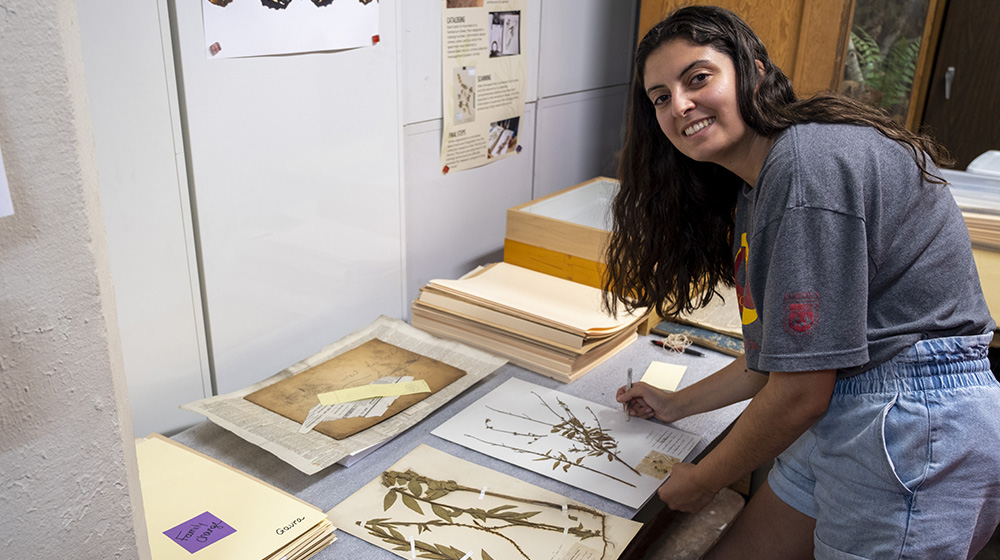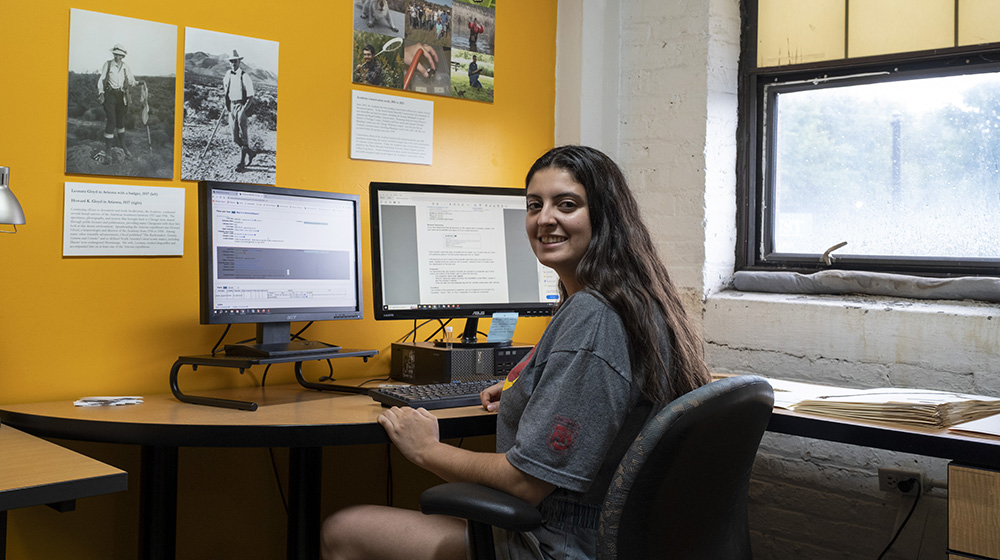Internship Vacanti
Exploring Botanical Treasures: Marinda Vacanti's Summer Internship Journey
Marinda Vacanti embarked on a transformative journey during her summer internship at the Peggy Notebaert Nature Museum. As a collections intern, Marinda's role focused on meticulously preserving and understanding botanical specimens, providing her with hands-on experience in museum collections.

Marinda Vacanti prepared botanical specimens as a collections intern at the Peggy Notebaert Nature Museum.
Marinda's pathway to this position began online, where she discovered the internship opportunity on the School of Environmental Sustainability (SES) website. The internship is available to Loyola students through a partnership between SES and the museum. Although unfamiliar with the nature museum before this, she found the job description intriguing and perfectly aligned with her interests as an environmental science major. Driven by her passion, she submitted her application and embarked on what would prove to be a fulfilling summer internship.
Her daily routine as a collections intern involved a dynamic combination of historical preservation and intellectual exploration. Marinda's primary responsibility was to meticulously catalog a substantial backlog of roughly 6,000 botany specimens dating from the 1850s to the early 1900s. This intricate process encompassed various stages, beginning with the careful mounting of specimens. Subsequently, Marinda digitally cataloged them in the museum's online database, ensuring their accessibility to researchers and enthusiasts worldwide. Moreover, her involvement extended to labeling, digital scanning for archival purposes, and seamlessly integrating the specimens into the museum's expansive collection.
Marinda discovered a profound sense of enjoyment in her responsibilities. "My favorite part about working in this internship is doing additional research about the specimens so I'm able to identify them," she enthusiastically shared. This process added an element of mystery and intrigue to her work. Each specimen held a story from a different era, and Marinda's role involved deciphering their origins and identities. She adeptly compared the specimens' origins to the native plant species of their respective areas, weaving together historical narratives.

Marinda digitally cataloged plant specimens in the museum's online database.
Marinda's academic journey at Loyola University significantly contributed to her success during this internship. Reflecting on her experiences, she noted, "In some of the classes that I had taken at Loyola, such as in my ecology lab, I learned about the basics of plant identification and had the chance to practice these skills in the field." Her exposure to courses covering ecology, biodiversity, and biogeography equipped her with the essential knowledge required for identifying and contextualizing plant species. This valuable skillset greatly assisted her in the internship.
As the internship concluded, Marinda reflected on its impact on her post-graduation aspirations. "Working at this internship has prepared me for after I graduate," she affirmed. Through her engagement in a professional setting, Marinda honed field-specific skills and gained more profound insights into potential career trajectories. Her journey exemplified the remarkable potential of a summer internship, offering a preview of the exciting opportunities that lie ahead beyond the academic realm.
Learn more about internship opportunities for SES students here.
--Story and photos by Jorge Haddad
Exploring Botanical Treasures: Marinda Vacanti's Summer Internship Journey
Marinda Vacanti embarked on a transformative journey during her summer internship at the Peggy Notebaert Nature Museum. As a collections intern, Marinda's role focused on meticulously preserving and understanding botanical specimens, providing her with hands-on experience in museum collections.
Marinda's pathway to this position began online, where she discovered the internship opportunity on the School of Environmental Sustainability (SES) website. The internship is available to Loyola students through a partnership between SES and the museum. Although unfamiliar with the nature museum before this, she found the job description intriguing and perfectly aligned with her interests as an environmental science major. Driven by her passion, she submitted her application and embarked on what would prove to be a fulfilling summer internship.
Her daily routine as a collections intern involved a dynamic combination of historical preservation and intellectual exploration. Marinda's primary responsibility was to meticulously catalog a substantial backlog of roughly 6,000 botany specimens dating from the 1850s to the early 1900s. This intricate process encompassed various stages, beginning with the careful mounting of specimens. Subsequently, Marinda digitally cataloged them in the museum's online database, ensuring their accessibility to researchers and enthusiasts worldwide. Moreover, her involvement extended to labeling, digital scanning for archival purposes, and seamlessly integrating the specimens into the museum's expansive collection.
Marinda discovered a profound sense of enjoyment in her responsibilities. "My favorite part about working in this internship is doing additional research about the specimens so I'm able to identify them," she enthusiastically shared. This process added an element of mystery and intrigue to her work. Each specimen held a story from a different era, and Marinda's role involved deciphering their origins and identities. She adeptly compared the specimens' origins to the native plant species of their respective areas, weaving together historical narratives.
Marinda's academic journey at Loyola University significantly contributed to her success during this internship. Reflecting on her experiences, she noted, "In some of the classes that I had taken at Loyola, such as in my ecology lab, I learned about the basics of plant identification and had the chance to practice these skills in the field." Her exposure to courses covering ecology, biodiversity, and biogeography equipped her with the essential knowledge required for identifying and contextualizing plant species. This valuable skillset greatly assisted her in the internship.
As the internship concluded, Marinda reflected on its impact on her post-graduation aspirations. "Working at this internship has prepared me for after I graduate," she affirmed. Through her engagement in a professional setting, Marinda honed field-specific skills and gained more profound insights into potential career trajectories. Her journey exemplified the remarkable potential of a summer internship, offering a preview of the exciting opportunities that lie ahead beyond the academic realm.
Learn more about internship opportunities for SES students here.
--Story and photos by Jorge Haddad
